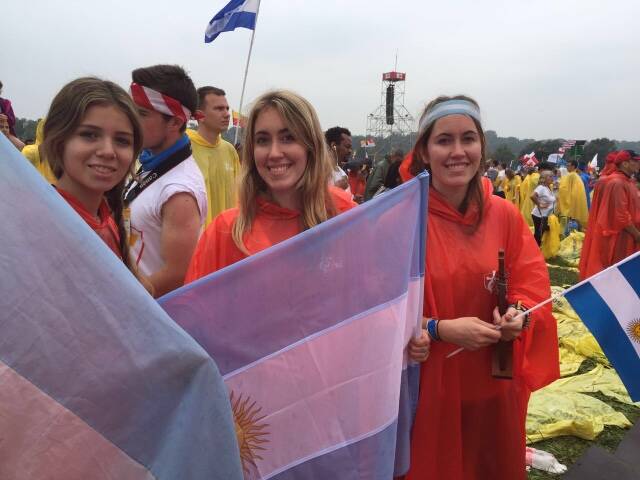Six thousand young Argentinians came to Krakow for the World Youth Day, and among them was a high school student from Buenos Aires, Paula (‘Poli) Piqué, who had traveled to Rio de Janeiro to participate in the first World Youth Day led by Pope Francis.
She returned home so “spiritually energized and excited” from that international gathering, which brought together four million young people from all continents, that she has decided to attend this W.Y.D. in Krakow, Poland, because, she told America, “I want to live that experience again.”
This time, however, Poli, a 19-year-old student of social communications at Austral University in Buenos Aires, brought two others with her: her twin sister Isabella (‘Isa’) and a very close friend, Alexia. (Poli and her twin sister are nieces of my wife, Elisabetta Piqué.) They were so captivated by what she told them about her experience in Rio that they decided to come with her to Poland in the hope of experiencing similar “spiritual feelings.”
A recent survey has shown that most young people (ages 14-35) come to W.Y.D. to be with Jesus and with the pope. Poli and her friends fit the pattern. She came to Krakow, she said, because in Rio she “felt the presence of God” and was inspired by “the presence of Pope Francis” and by “being with millions of young Catholics from so many different countries.”
She confided: “Rio changed my way of seeing things. I feel the presence of God in my life. I feel the desire to go on mission and ‘shake things up’ (Hagan lio!), as Francis told us.” When she returned home from Rio she “went on mission” talking about Jesus to people in other parts of Argentina who knew little about him.
Poli, Isabella and Alexia told me, when I met them in Krakow, that they experienced similar “spiritual feelings” here to what Poli had felt in Rio as they mixed and interacted with many of the 1.5 million young people from 187 countries in the various events—catechesis, prayers and the big events with the pope: the opening ceremony, the Way of the Cross, the prayer vigil, sleeping overnight after the vigil in the Mercy Field (Campus Misericordiae) and then the closing Mass. The experienced a “tsunami” of emotions and were sad to leave at the end.
All three have come from Buenos Aires as part of a larger group from the Schoenstatt movement in Argentina and Chile. They are not members of this Marian renewal movement, which was founded in Germany in 1914, but they are close to it and joined this pilgrimage to W.Y.D. that it organized. Before coming to Krakow, they visited the holy sites in Rome and Assisi as well as the headquarters of the movement in Germany.
They were overjoyed to be with Pope Francis because, Poli said, expressing their shared view, “He is Argentinian like us, we connect better with him, we understand him better. He inspires us.”
Alexia de Bary, 18, a psychology student at El Salvador University in Buenos Aires, said she has came because of what Paula had told her about Rio.” She said, “My religion is very important to me and very present in my life.” She has gone on a number of retreats and done some missionary work, “speaking about Jesus” in places where they know little about him. She also visits one of the city’s shantytowns.
She was particularly delighted to be at this W.Y.D. with the pope and other teenage Catholics from different countries who share the same faith, particularly, she said, since so many teenagers even back in Argentina focus on other things in their lives. “I feel this W.Y.D. is a very good thing for me; it helped me to connect with God and share my culture and religion with other young people.” She considers it “very significant” that the pope is Argentinian and added, “I know that more teenagers than before focus on God and religion since Bergoglio became pope.”
Isabella, Paula’s twin sister, studies psychology like Alexia but at the Austral University. She decided to come to this W.Y.D. because she saw her sister “so happy and energized” after the “wonderful” Rio experience. She rated this experience as “both necessary and important,” and said she now feels particularly strengthened in her faith “through my meeting with so many other young people that believe in God and share the same values and religion like me.”
Isa, her sister and Alexia are all inspired by “the humility and sensitivity” of Pope Francis, and his concern for the poor. They said he has taught them that “having less is not the worst thing in life” and that “being rich is not what makes you happy.”
“Here in Krakow he has challenged us to build our relationship with Jesus, and as he said at Mass today to have courage to overcome evil with good by loving everyone, even our enemies. He gives us hope that we can make a difference in the world. And that makes us happy!”








